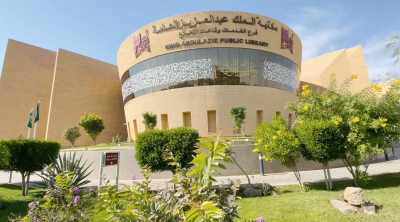
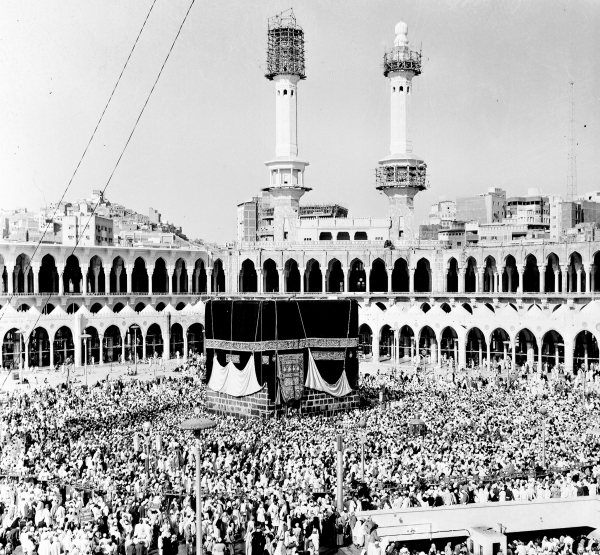
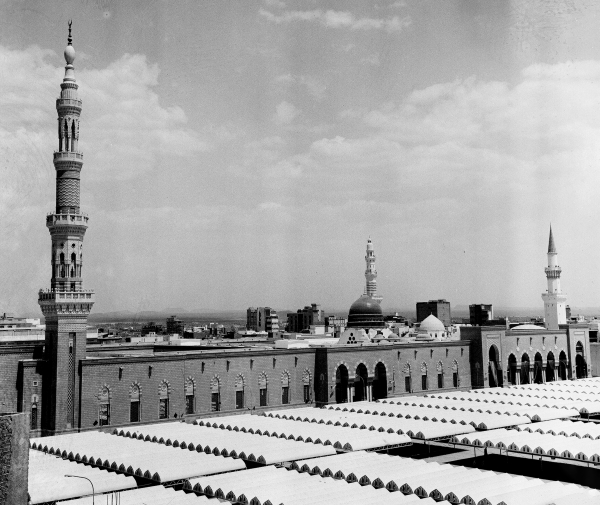
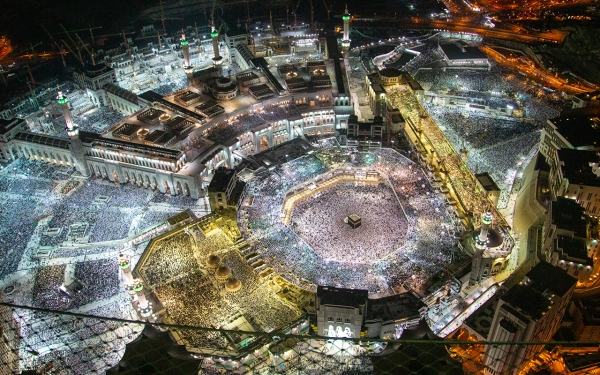
The Saudi expansion of the Two Holy Mosques encompasses increases in area, restorations, and construction and architecture work implemented in the Grand Mosque and the Prophet's Mosque during the Saudi era.
The Saudi expansion of the Two Holy Mosques was related to the beginnings of the unification of the Kingdom of Saudi Arabia. The restoration of the Grand Mosque was the first work of the Founding King Abdulaziz Bin Abdulrahman Al Saud after he entered Makkah al-Mukarramah in 1924. The expansion was characterized by a combination of faith and practical motives. King Abdulaziz is the fifth person who combined expansion and architecture in the history of the Two Holy Mosques, after the two Rashidun Caliphs Umar Bin al-Khattab and Uthman Bin Affan, the Umayyad Caliph al-Walid Bin Abd al-Malik, and the Abbasid Caliph Mohammed al-Mahdi.
The Founding King Abdulaziz was the first to light up the entire Grand Mosque with electricity. He also separated the Mas'aa from the public markets, incorporating it into the Grand Mosque. He was also the first to increase the capacity of the Prophet’s Mosque by 58.46 percent.
In the first Saudi expansion in 1926, the renovation of the Grand Mosque's colors began, and its floors were replaced by marble. In the following year, canopies were set up to shade worshipers in the circumambulation (Tawaf) courtyard.
In 1928, Founding King Abdulaziz ordered the establishment of the first factory dedicated to manufacturing the Kiswa for al-Kaaba al-Musharrafa. He also commanded the pavement of the Mas'aa with granite stone and the removal of nearby shops.
The area of Mas'aa doubled during the reign of King Saud Bin Abdulaziz Al Saud. A second floor was constructed, and a new building was established for the distribution of Zamzam water. A pump was installed to elevate its water, and the basement of Zamzam was equipped with taps and a drainage system for used water. A comprehensive restoration of al-Kabaa al-Musharrafa was carried out, which involved replacing both the upper and lower roofs and repairing the cracks in the walls.
Expansion works during the reign of King Faisal Bin Abdulaziz Al Saud
King Faisal Bin Abdulaziz Al Saud continued the expansion works started by his brother King Saud Bin Abdulaziz. During his reign, the structure surrounding Maqam Ibrahim was removed to allow for expansion in both directions. The Maqam was then covered with a glass dome in 1967. Additionally, the library of the Grand Mosque was constructed, and the factory dedicated to the Kiswa for al-Kaaba al-Musharrafa was built in its current location in Umm al-Joud Neighborhood.
In 1978, the expansion of the Mataf area began. Its floor was paved with heat-resistant marble. The minbar and the mukabbariyah were relocated, and the Zamzam well was expanded. Its entrance became closer to the side of the Mas'aa.
Expansion works during the reign of King Khalid Bin Abdulaziz Al Saud
The door of al-Kaaba al-Musharrafa was replaced with a door from pure gold during the reign of King Khalid Bin Abdulaziz in 1979, incorporating 280 kg of pure gold, which is the largest mass of manufactured gold in the world. It still stands in its place in al-Kaaba al-Musharrafa to this day.
During the Hajj of 1983, the highest number of pilgrims coming from abroad was achieved, exceeding one million pilgrims.
Expansion works during the Reign of King Fahd
In 1996, King Fahd Bin Abdulaziz Al Saud carried out a thorough and precise restoration of al-Kaaba al-Musharrafa. King Fahd also completed an expansion of the Grand Mosque on its western side.
The third Saudi expansion
During the reign of King Abdullah Bin Abdulaziz Al Saud, the third Saudi expansion began. It was inaugurated during the reign of the Custodian of the Two Holy Mosques King Salman Bin Abdulaziz Al Saud. It is considered the largest in the Grand Mosque in history, as it raised the prayer capacity to two million worshipers. Expansion work is still ongoing during his reign. The third Saudi expansion of the Grand Mosque includes: external courtyards, restrooms, walkways, tunnels, service areas, as well as water and electricity stations.
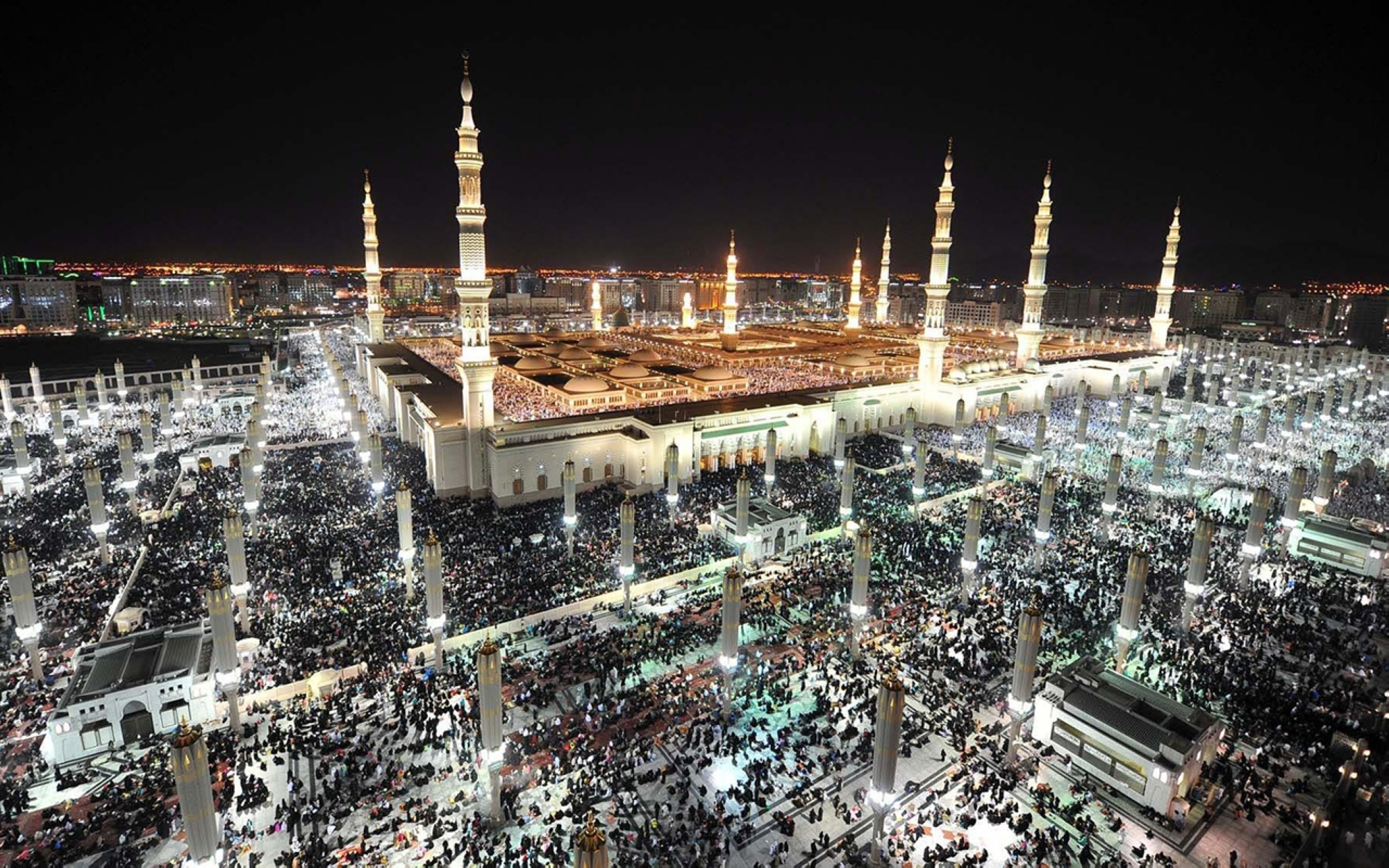
Expansion works in the Prophet's Mosque
The first Saudi reforms at the Prophet's Mosque came about following King Abdulaziz's first trip to al-Madinah al-Munawwarah in 1926. The first expansion of the mosque was officially announced by a directive by King Abdulaziz in a formal speech he delivered in 1949. Within just two years, expansion works commenced, with the owners of the buildings surrounding the mosque receiving compensation to include their areas to the premises of Prophet's Mosque.
King Saud Bin Abdulaziz continued to expand and develop the Prophet’s Mosque, adding 12,270 m to the mosque after the expansion, in addition to the 4,057 m that constituted the main area of the Prophet’s Mosque.
Due to the growing number of visitors, King Faisal Bin Abdulaziz issued an order to expand the prayer area west of the Prophet's Mosque. Building owners in the area were compensated, and their properties were integrated into the mosque's praying spaces. These spaces were tiled with marble flooring, ventilated, and lighted. The area totaled 30,406 m shaded by eighty canopies.
During the reign of King Khalid Bin Abdulaziz, a fire broke out in the cloth market next to the Prophet’s Mosque in 1977. Its owners received compensation, and its area was added to the expansion of King Faisal Bin Abdulaziz.
The second Saudi expansion of the Prophet’s Mosque came under the guidance of King Fahd Bin Abdulaziz who laid the foundation stone of the project in 1985. It was completed in 1993. The expansion included the eastern, western, and northern sides of the mosque. An area of 82,000 m² was added to it, with a capacity of 150 thousand worshipers.
The third Saudi expansion of the Two Holy Mosques began during the reign of King Abdullah Bin Abdulaziz. Upon completion of the expansion, the capacity for worshipers is expected to accommodate approximately 1.8 million individuals. Concurrently, the expansion of the Prophet's Mosque is progressing, now under the reign of King Salman Bin Abdulaziz Al Saud.
Related quizzes

